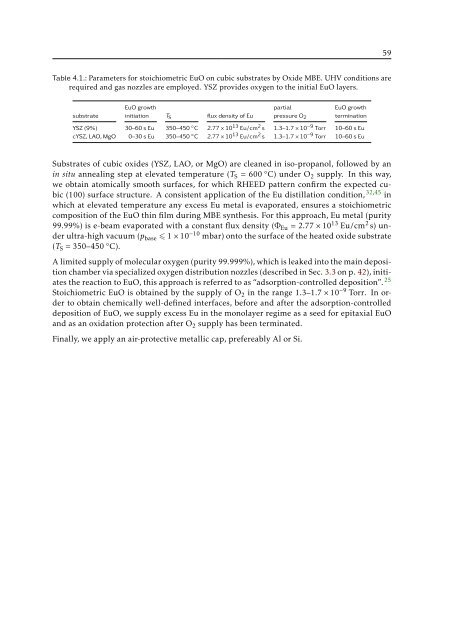Text anzeigen (PDF) - Universität Duisburg-Essen
Text anzeigen (PDF) - Universität Duisburg-Essen
Text anzeigen (PDF) - Universität Duisburg-Essen
You also want an ePaper? Increase the reach of your titles
YUMPU automatically turns print PDFs into web optimized ePapers that Google loves.
59<br />
Table 4.1.: Parameters for stoichiometric EuO on cubic substrates by Oxide MBE. UHV conditions are<br />
required and gas nozzles are employed. YSZ provides oxygen to the initial EuO layers.<br />
EuO growth partial EuO growth<br />
substrate initiation T S flux density of Eu pressure O 2 termination<br />
YSZ (9%) 30–60 s Eu 350–450 ◦ C 2.77 × 10 13 Eu/cm 2 s 1.3–1.7 × 10 −9 Torr 10–60 s Eu<br />
cYSZ, LAO, MgO 0–30 s Eu 350–450 ◦ C 2.77 × 10 13 Eu/cm 2 s 1.3–1.7 × 10 −9 Torr 10–60 s Eu<br />
Substrates of cubic oxides (YSZ, LAO, or MgO) are cleaned in iso-propanol, followed by an<br />
in situ annealing step at elevated temperature (T S = 600 ◦ C) under O 2 supply. In this way,<br />
we obtain atomically smooth surfaces, for which RHEED pattern confirm the expected cubic<br />
(100) surface structure. A consistent application of the Eu distillation condition, 32,45 in<br />
which at elevated temperature any excess Eu metal is evaporated, ensures a stoichiometric<br />
composition of the EuO thin film during MBE synthesis. For this approach, Eu metal (purity<br />
99.99%) is e-beam evaporated with a constant flux density (Φ Eu = 2.77 × 10 13 Eu/cm 2 s) under<br />
ultra-high vacuum (p base 1 × 10 −10 mbar) onto the surface of the heated oxide substrate<br />
(T S = 350–450 ◦ C).<br />
A limited supply of molecular oxygen (purity 99.999%), which is leaked into the main deposition<br />
chamber via specialized oxygen distribution nozzles (described in Sec. 3.3 on p. 42), initiates<br />
the reaction to EuO, this approach is referred to as “adsorption-controlled deposition”. 25<br />
Stoichiometric EuO is obtained by the supply of O 2 in the range 1.3–1.7 × 10 −9 Torr. In order<br />
to obtain chemically well-defined interfaces, before and after the adsorption-controlled<br />
deposition of EuO, we supply excess Eu in the monolayer regime as a seed for epitaxial EuO<br />
and as an oxidation protection after O 2 supply has been terminated.<br />
Finally, we apply an air-protective metallic cap, prefereably Al or Si.
















